Augmented Reality (AR) is transforming education, bringing interactive and immersive experiences directly into classrooms. Unlike traditional teaching tools, AR bridges the gap between theoretical concepts and hands-on learning by overlaying digital information onto the physical world.
Imagine students exploring the solar system in 3D, dissecting a virtual human heart, or simulating chemical reactions without a lab. AR turns learning into an adventure, making abstract subjects accessible and engaging for learners of all ages. With its growing presence in schools, AR is shaping the future of education, offering tools that not only enhance understanding but also spark curiosity and creativity.
In this article, we’ll dive into the top 5 applications of AR in classroom settings, showcasing how this technology is revolutionizing the learning experience. Let’s explore!
AR for Interactive Science Learning
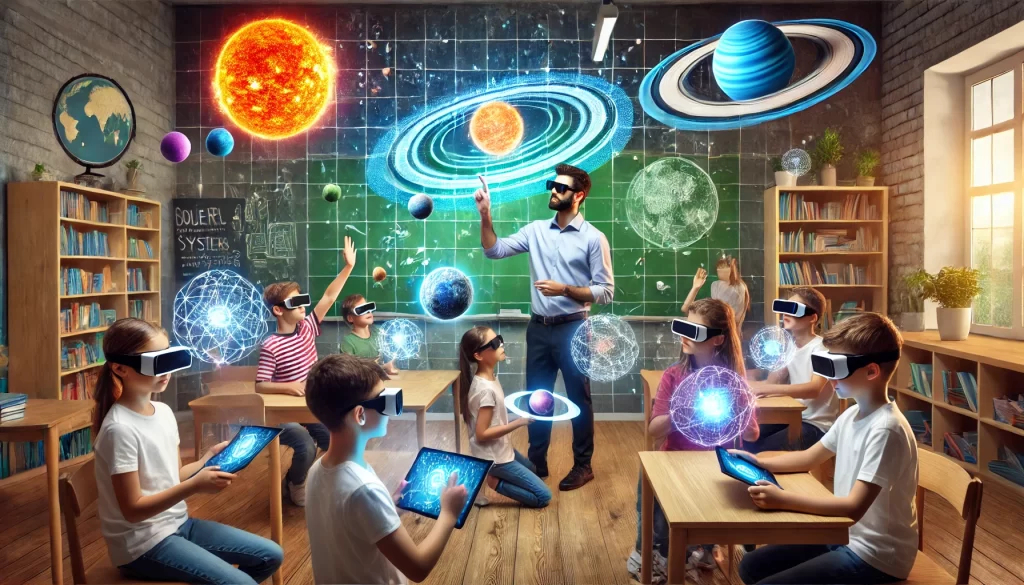
Augmented Reality (AR) is a game-changer in science education, turning abstract concepts into interactive, visual experiences. By bringing scientific phenomena to life, AR helps students understand complex topics in ways that traditional methods cannot achieve.
Key Applications in Science Learning:
- Human Anatomy Exploration: Students can virtually dissect organs, examine systems, and understand human biology through AR. For example, tools like Human Anatomy Atlas enable learners to interact with detailed 3D models.
- Astronomy Lessons: AR brings the universe into the classroom. Apps like Star Walk allow students to observe constellations, planets, and galaxies interactively.
- Chemical Reactions Visualization: Students can see molecules interact in real-time, understanding processes that are otherwise hard to visualize. Apps like Chem101 AR provide virtual chemistry labs to safely simulate experiments.
- Environmental Simulations: AR can recreate ecosystems such as rainforests or coral reefs, offering students a virtual field trip. Apps like ARki immerse students in habitats to explore biodiversity.
Why It Matters
Science becomes more engaging and accessible with AR. These tools cater to different learning styles, especially visual and kinesthetic, and help students grasp complex concepts with ease. By fostering curiosity and interaction, AR can significantly improve educational outcomes in STEM fields.
Enhancing Language Learning with AR
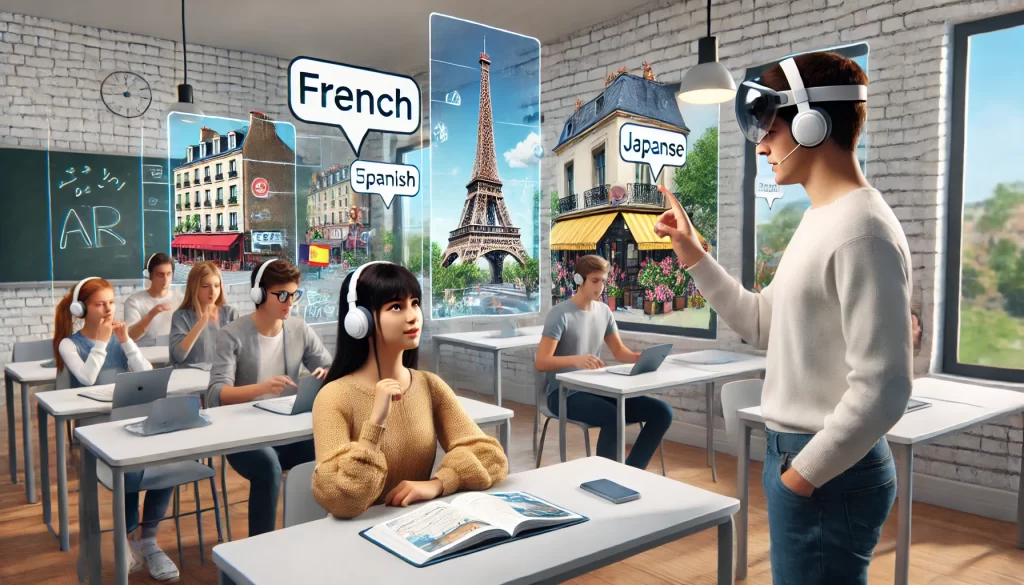
Language learning becomes more dynamic and engaging with Augmented Reality (AR), as students can practice and immerse themselves in realistic scenarios. AR applications create interactive environments where learners can converse with virtual characters, explore cultural settings, and develop language skills in context.
Key Applications in Language Learning:
- Virtual Conversations: AR apps create realistic avatars or characters that students can interact with, helping them practice pronunciation, vocabulary, and grammar.
- Example: Mondly AR offers life-like conversations to simulate real-world speaking experiences.
- Cultural Immersion: Students can virtually explore different countries, landmarks, and traditions, gaining cultural insights while practicing the language.
- Example: An AR app might guide students through a virtual tour of Paris, complete with French dialogues.
- Interactive Storytelling: AR makes stories come alive, enabling students to follow plots interactively while learning new words and phrases.
- Example: AR-enhanced eBooks for language learners add animations and audio cues for better engagement.
Why It Matters
AR offers an immersive, hands-on approach to language learning, making it easier and more enjoyable for students to grasp complex language structures. By practicing in virtual environments, learners gain confidence and fluency that traditional methods often struggle to provide.
AR for History Lessons
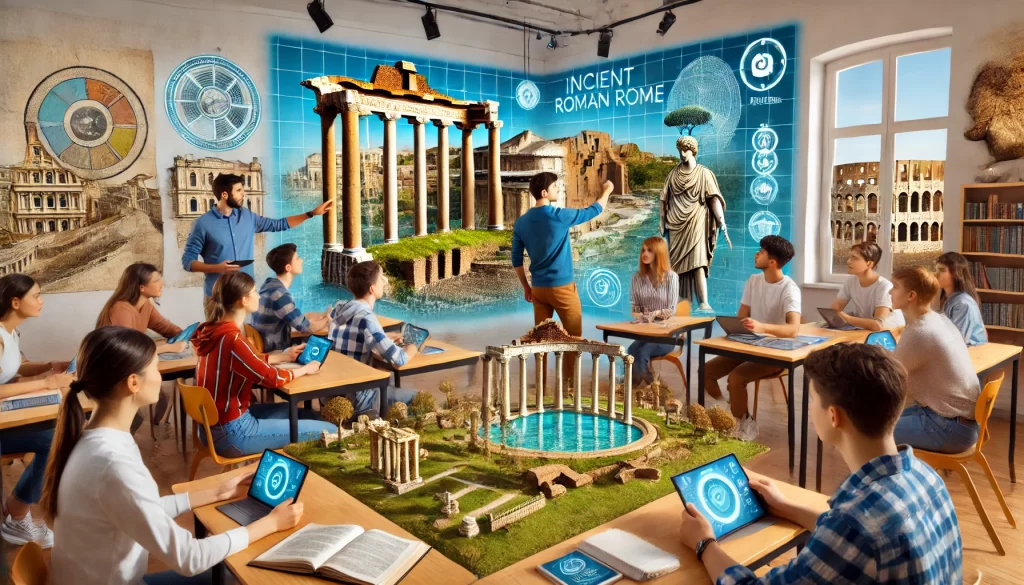
History comes alive with Augmented Reality (AR), enabling students to explore events, cultures, and landmarks in a way that textbooks alone cannot achieve. AR allows learners to interact with 3D recreations of historical events and locations, immersing them in the past for a richer educational experience.
Key Applications in History Learning:
- Recreating Historical Events: AR tools can simulate key moments in history, like the signing of the Declaration of Independence or the building of the Great Wall of China.
- Example: Apps like Time Travel AR enable students to witness and interact with these moments virtually.
- Exploring Ancient Civilizations: Students can virtually walk through the streets of Ancient Rome or tour the pyramids of Egypt, gaining firsthand insights into how people lived.
- Example: Civilization AR lets users explore reconstructed ancient worlds in detail.
- Landmark Simulations: AR allows students to experience famous monuments, such as the Colosseum or the Taj Mahal, from their classroom.
- Example: Google Expeditions AR provides virtual tours with added historical context.
Why It Matters
AR history lessons make learning more engaging by fostering curiosity and empathy. Students can better connect with historical figures and events, which helps improve retention and critical thinking skills.
Gamified Learning Experiences
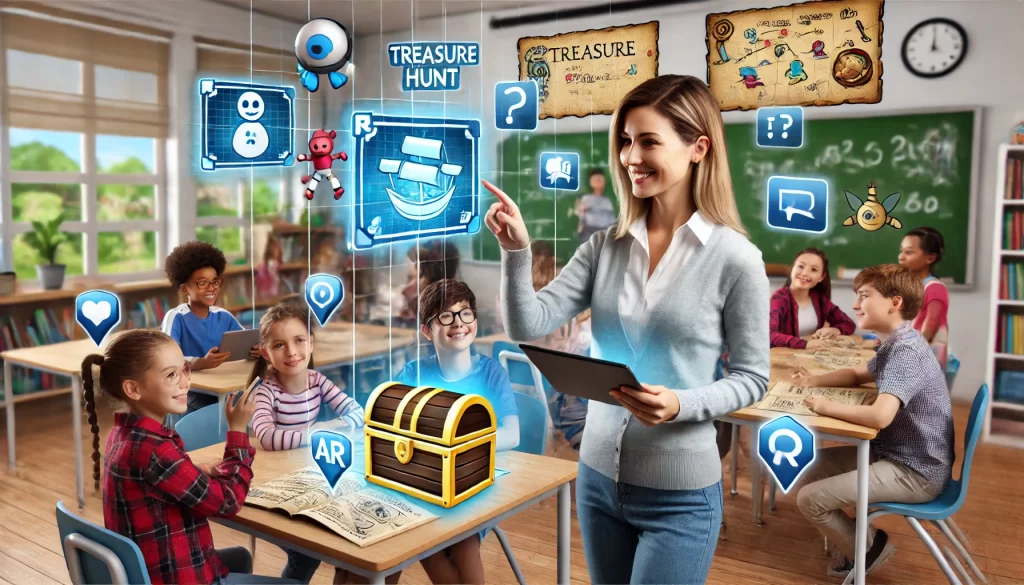
Gamification is transforming education, and with Augmented Reality (AR), it takes engagement to a whole new level. AR combines learning and play, creating an interactive and fun environment that motivates students to actively participate in their education.
Key Applications in Gamified AR Learning:
- Interactive Quizzes and Challenges: AR-powered apps create interactive games where students solve puzzles or answer questions to progress through educational adventures.
- Example: ARQuiz lets students unlock virtual treasures by solving subject-related challenges.
- Virtual Treasure Hunts: Students can embark on AR treasure hunts to learn geography, history, or math by solving riddles and exploring their surroundings.
- Example: Apps like Seek Education AR offer customizable quests tied to classroom lessons.
- Problem-Solving Games: AR transforms problem-solving exercises into engaging scenarios, such as helping a virtual character or solving a mystery.
- Example: AR apps like Mission Math AR challenge students to apply mathematical concepts in gamified missions.
Why It Matters
Gamified AR tools encourage active participation, enhance retention, and make learning more enjoyable. They can improve problem-solving skills and foster collaboration as students work together to complete tasks and achieve goals.
AR in STEM Education
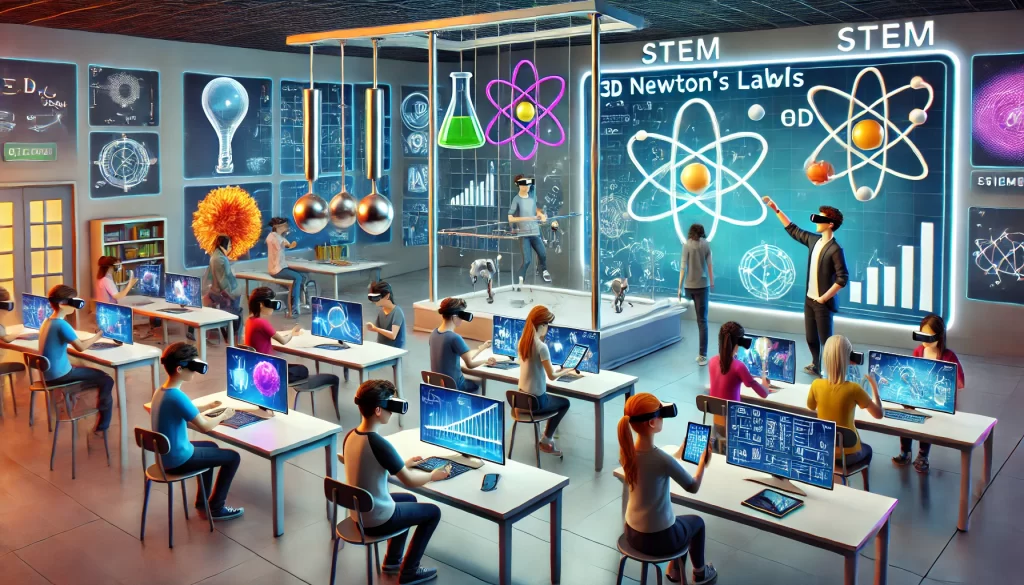
Augmented Reality (AR) is redefining STEM (Science, Technology, Engineering, and Mathematics) education by providing students with hands-on, interactive experiences. AR tools allow learners to visualize and manipulate complex concepts, making STEM subjects more engaging and accessible.
Key Applications in STEM Learning:
- Physics Simulations: Students can experiment with forces, motion, and energy through AR-enabled physics labs, understanding principles in real-time.
- Example: Apps like Newton AR simulate physics experiments, making abstract concepts tangible.
- Engineering Design and Prototyping: AR helps students create and test virtual prototypes, enhancing their understanding of engineering principles.
- Example: ARPro Designer allows students to design and analyze structural models in 3D.
- Mathematics Visualization: AR tools turn equations and graphs into interactive 3D visuals, making complex math topics easier to grasp.
- Example: Apps like GeoGebra AR let students explore geometry and algebra interactively.
- Biology and Chemistry Labs: Virtual AR labs simulate experiments, reducing safety risks and costs while enabling hands-on practice.
- Example: Labster AR provides virtual experiments for biology and chemistry courses.
Why It Matters
AR in STEM education empowers students to explore, experiment, and innovate in ways traditional methods cannot. It fosters critical thinking, creativity, and collaboration while preparing learners for real-world applications of STEM knowledge.
Conclusion
Augmented Reality (AR) is revolutionizing education by turning classrooms into dynamic and interactive learning environments. From exploring the complexities of science and history to enhancing language learning and gamifying lessons, AR offers endless possibilities for making education engaging and effective. It fosters curiosity, encourages collaboration, and equips students with the skills they need for the future.
As schools increasingly adopt AR, the technology not only transforms traditional learning but also prepares students for a world driven by innovation and technology. By integrating AR into classroom settings, educators can unlock new potentials in teaching, creating experiences that students will remember for a lifetime.

Paul Graham, a renaissance man of the tech world, is a computer scientist, Lisp advocate, and prolific blogger. His insightful essays explore various tech and startup topics, making him a thought leader in the industry.